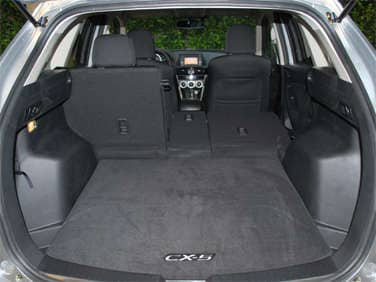Recent Articles
Popular Makes
Body Types
2013 Mazda CX-5 First Drive Review
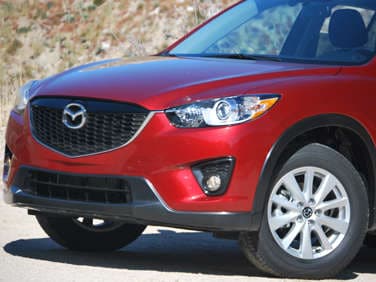
Mazda recently introduced its new Skyactiv branding on the updated Mazda3, but the first vehicle to incorporate and be designed around these weight- and fuel-saving technologies is the all-new 2013 Mazda CX-5. Designed to be a replacement for the aged Mazda Tribute, the new CX-5 breathes sporty, stylish and fuel efficient life into the crowded compact crossover segment. With its new CX-5 going on sale early next year, Mazda let us spend some time with some "80-percent completed" units ahead of the crossover's official debut at the 2011 Los Angeles International Auto Show. Mazda points out that crossover segment often forces buyers to choose between styling, fuel economy, comfort and driving pleaser, but the new CX-5 manages to incorporate all into small crossover - all at an affordable price.
2013 Mazda CX-5 First Drive Review: Pricing and Trim Levels
Assembled in Japan, the 2013 Mazda CX-5 will be offered in three trim levels (Sport, Touring and Grand Touring), but official pricing has yet to be announced. Expect the new CX-5 to start well below the CX-7 (which has a starting MSRP of $21,990 for 2011), but this number is likely to be closer to the Kia Sportage, one of its key competitors, which starts under $19,000 for 2012; a fully loaded 2013 CX-5 should come in at well under $30,000. With this kind of pricing and packaging, Mazda is targeting a variety of buyers including young professionals just starting careers and empty-nesters looking to downsize without losing a practical vehicle.
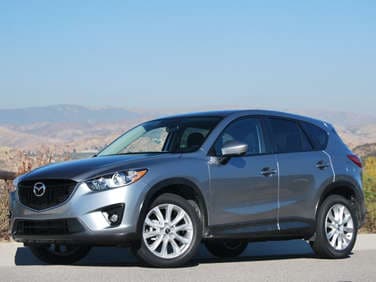
2013 Mazda CX-5 First Drive Review: Competition
The compact crossover segment is probably one of the most competitive in the automotive industry, but the 2013 Mazda CX-5 offers a unique blend of fuel economy, cabin space and styling to go up against the segment's top sellers, the Ford Escape and Honda CR-V, as well as the Kia Sportage, Volkswagen Tiguan and Toyota RAV4. The CX-5 will complement the CX-7 and CX-9 crossovers, and it will be one of the automaker's core products alongside the Mazda3 (known as the Axela in other markets). Globally, Mazda plans to sell around 160,000 units annually around the globe with the U.S. crossover market being one of the most important with Mazda quoting 2010 sales around 1.2 million and expecting the market to grow to 1.6 million by 2015.
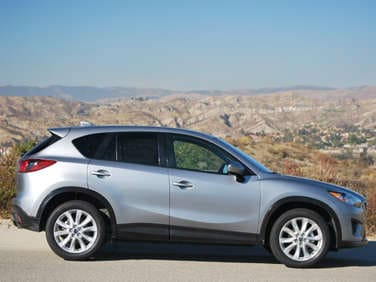
2013 Mazda CX-5 First Drive Review: Exterior
The term "best-in-class" is rarely applied to a vehicle's looks due to being subjective, but it would be hard to argue that the 2013 Mazda CX-5 doesn't raise the bar for styling in the compact crossover segment thanks to its injection of Mazda's "zoom-zoom" spirit. If the styling of the 2013 Mazda CX-5 looks familiar, that's because it is based on the 2011 Minagi Concept and carries over most of the same styling elements that the concept displayed earlier this year at the Geneva Motor Show.
This new "KODO" design language incorporates many of the themes introduced on the Shinari Concept including the signature wing element that makes up the lower part of the prominent grille and then it cuts into each headlight. From there, the arched fenders and side body creases create an athletic, cheetah-like profile that makes the CX-5 look like it is ready to pounce. Surprisingly, as nice as the crossover looks from the front and side, the CX-5's chief designer, Masashi Nakayama, said that his favorite angle is from the rear view where the Minagi's integrated exhaust outlets have been replaced by large red reflectors replace, but the other key styling elements remain including the body-colored spoiler and the horizontal taillights that are tied together by an arched body line that spans the liftgate.
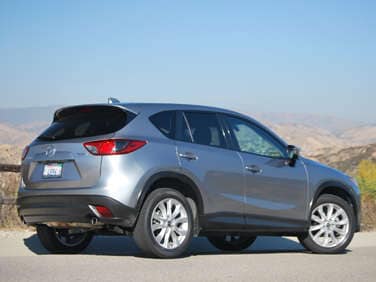
2013 Mazda CX-5 First Drive Review: Interior
Inside the 2013 Mazda CX-5, designers were tasked with making the crossover competitive without losing its Mazda-ness, and the end result was a spacious interior that can comfortably seat five passengers and a "special space" for the driver with a cockpit-like compartment to add to the CX-5's overall driving experience. Unlike most concept-to-production vehicles, the CX-5 does a good job of carrying over some of the concept's notable design cues that include the sporty steering wheel, satin chrome accents on the center stack and door panels, a piano black accent running across the middle of the instrument panel and a three-gauge instrument cluster. These particular CX-5 vehicles used for this event were early pre-production units (Mazda said close to 80 percent production ready), so we will hold our final judgment for the CX-5's trim quality and fit and finish. That being said, though, the seats were comfortable along our 150-mile drive, and the CX-5 feels roomier than the Tribute that it replaces and some of the newer rivals on the market; even compared to the slightly bigger CX-7, the CX-5 offers almost three inches of added rear-seat legroom.
One of the most unique elements of the CX-5 cabin is the 40-20-40 split rear seat. While Mazda isn't the first to deliver this kind of rear-seat split, it does offer an innovative, easy-to-use one-touch operation using levers in the cargo area to independently operate each of the seat's three sections. With all three sections folded down, the CX-5 delivers up to 65.4 cubic feet of cargo volume (34.1 cubic feet of space is available with the seats up).
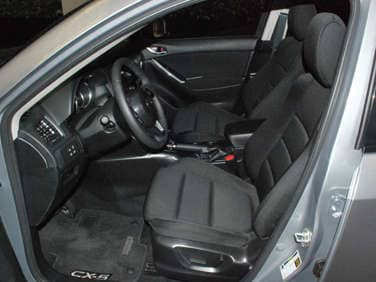
2013 Mazda CX-5 First Drive Review: Interior Packages and Options
The Sport and Touring trim levels of the 2013 Mazda CX-5 will offer a pair of cloth interiors in an all-black look and a black-and-beige color scheme. The base CX-5 Sport comes with a surprising amount of standard equipment such as 17-inch wheels and push-button start, while the CX-5 Touring (expected to account for about half of all sales) will add more upscale features like blind-spot monitoring, HD Radio and a backup camera. The top-of-the-line CX-5 Grand Touring will stand out with its Bose audio system and leather interior. Aside from the three trim levels, the 2013 Mazda CX-5 will be offered with four main options packages. Sport models can add the Bluetooth Audio Package which upgrades to Bluetooth audio streaming and phone pairing along with a backup camera. The Touring models can add the self-explanatory Moonroof and Bose Package and the Tech Package which brings Tom Tom navigation, HID headlights and rain-sensing wipers; the Grand Touring can also be optioned with the latter package.
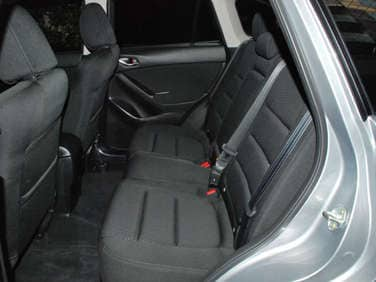
2013 Mazda CX-5 First Drive Review: Powertrain and Fuel Economy
In the U.S., the 2013 Mazda CX-5 will launch with only the 2.0-liter Skyactiv-G inline-four gasoline engine, but fans of even more enthusiastic and fuel-efficient driving will want to mark 2013 on their calendar. Mazda has said that it plans on bringing the new Skyactiv-D diesel engine to the U.S. in 2013, and although it did not say which vehicle this engine would debut in, the European-spec CX-5 will offer this engine at launch. Like the CX-5 itself, the Skyactiv-G is a completely new engine that has been optimized for performance and efficiency with lower weight, higher compression and less internal friction (and parasitic power loss) all of which help make the engine's 155 horsepower and 150 lb-ft of torque more enjoyable. Attentive eyes will notice that the CX-5's torque rating is slightly higher than the Mazda3 which uses this same engine, and this is a result of the unique 4-2-1 exhaust manifold not used on the 3.
The 2013 CX-5 will offer both of Mazda's Skyactiv-branded transmissions, but while we had a brief opportunity to drive the Skyactiv-MT manual gearbox, most of our day was spent with the Skyactiv-Drive six-speed automatic transmission. Skyactiv-Drive stands out from other automatics on the market by adding the quick shifts of a dual clutch transmission with the low-speed smoothness of a conventional automatic's torque converter; to put it simply, the torque converter is locked up for take-offs (eliminating the jerky, low-speed operation of DCTs) and after about 5 miles per hour, the clutches take over. The result is a smooth and responsive transmission that adds to the driving enjoyment of the CX-5, and in manual mode, the transmission shifts are all dependant on the driver meaning that each gear can be held as long as the driver wants to with no babysitting upshifts and there is rev matching on downshifts. Fuel economy is also a crucial element of Skyactiv technologies, and the CX-5 is expected to return best-in-class EPA estimates of up to 26 miles per gallon in the city and 33 mpg on the highway (with the Skyactiv-MT), but we spent most of our time in the models with the automatic transmission which dropped highway fuel economy by 1 mpg. Mazda says that the all-wheel drive models will be rated at 25 mpg city and 30 mpg highway.
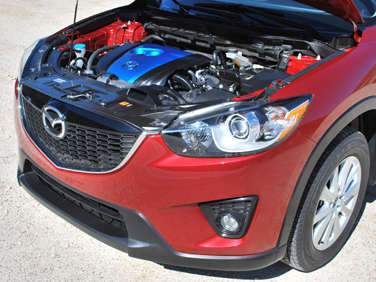
2013 Mazda CX-5 First Drive Review: Driving Impressions
Coming from the company that makes the MX-5 Miata and the Mazda3, the driving dynamic is where the 2013 Mazda CX-5 really stands out. In our recent drive along the Angeles Forest Highway (just outside of Los Angeles), the CX-5 was given the chance to show off how well it handles everything from sharp turns to rough road surfaces. When the roads got twisty, the ability to hold the transmission as long as possible was definitely an advantage which helped the little crossover accelerate even faster out of the turns. While these roads were fun to drive on, most CX-5 owners will likely be tackling city commutes and highway traffic, and once again Mazda showed it did its homework by tuning the electric power steering system to feel just as good in traffic at low speeds as it does while taking a blind hairpin turn on a mountain road. Mazda has also tuned the suspension with higher pivot points which is supposed to make for a smoother ride over bumps, and the CX-5 definitely handled itself well over varying road conditions including annoying interstate expansion joints and harsh road transitions in construction zones. We did not have the opportunity to drive the CX-5 off road, but it does feature a stiff chassis and 8.5 inches of ground clearance which means that it should be able to tackle most terrains it will encounter.
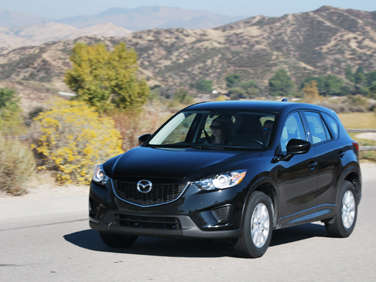
2013 Mazda CX-5 First Drive Review: Safety
Skyactiv is important to all aspects of the 2013 Mazda CX-5 and future Mazda vehicles... including safety. For starters, the compact size of the engine and transmission now allow for straighter front frame rails improving front-end collision safety, while 61-percent of the body and chassis (called Skyactiv-Body) is made up of high-tensile steel which reduces weight and creates a more rigid structure for improved handling. Mazda promises that each new car it comes out with will weigh significantly less than its predecessor, and the various CX-5 models weigh about 60 to 70 pounds less than the Tribute ranging from the base manual transmission Sport (3,208 pounds) up to the all-wheel drive versions (3,426 pounds). Mazda expects its new CX-5 to get top ratings from the National Highway Traffic Safety Administration (NHTSA) and Insurance Institute for Highway Safety (IIHS) thanks to plenty of standard safety features such as six airbags, active front head restraints, daytime running lights, four-wheel anti-lock disc brake system, tire pressure monitoring system (TPMS), Dynamic Stability Control (DSC) and traction control.
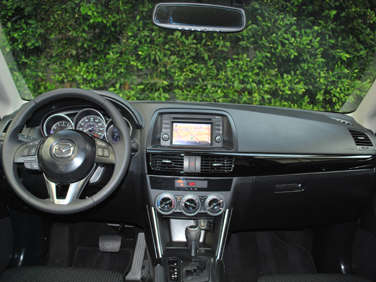
2013 Mazda CX-5 First Drive Review: Final Thoughts
The "no compromises" mentality that Mazda put into the 2013 Mazda CX-5 results in a solid family vehicle that is fuel efficient and fun to drive. After years of being an also-ran in the compact crossover segment with the Ford-based Tribute, the new CX-5 is poised to be a class leader in most attributes including fuel efficiency, handling and, of course, driving pleasure. Yes, the launch of the 2013 Ford Escape will have some assuming the two companies are still sharing parts, but rest assured, the CX-5 is 100 percent Mazda. Even more promising, Mazda indicated that all of its future front-wheel drive models will be based on the CX-5's platform.

2013 Mazda CX-5 First Drive Review: Pros and Cons
- smooth, sporty ride
- best-in-class fuel economy
- emotional exterior styling
- optional navigation available on all trim levels
- no paddle shifters on automatic transmission models
- manual transmission only offered on base Sport model
Mazda provided travel, lodging and vehicle for this review. Photos by Jeffrey N. Ross
